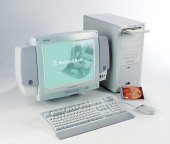|

Inside
the magazine
Self-help message board
Article reprints
How to contact us
Web links directory
Software downloads
Tips and advice
Fire-wire campaign
Subscribe today
Help Me, I'm new!
Fair pricing petition
Home

In
Software Downloads:
Adobe
Premiere 6 (trial)
Paint Shop Pro 7 (trial)
Tips
and Advice:
How to get started with
computer video editing
Fire-wire
Campaign:
Join our ongoing campaign
|
Packard
Bell Video Dre@m Machine
 You'd
think that buying a powerful, DV-ready Windows PC with truckloads of
software and a DVD-R burner would cost an arm and a leg. Amazingly,
that's not so. Packard Bell has come up with an inexpensive system that
has all these things, the Video Dre@m Machine You'd
think that buying a powerful, DV-ready Windows PC with truckloads of
software and a DVD-R burner would cost an arm and a leg. Amazingly,
that's not so. Packard Bell has come up with an inexpensive system that
has all these things, the Video Dre@m Machine
On paper, Packard
Bell's Video Dre@m Machine promises to be the home video novice's ideal
PC. A 1GHz Pentium III processor coupled with 128MByte RAM and an excellent
nVIDIA GeForce 2 MX graphics card make this an excellent workhorse,
and it comes with enough office software, games and educational programs
to make it an effective starter machine for family use. Add to that
it's built-in OHCI FireWire and Pioneer DVR-A03 DVD writer, and the
Dre@m Machine lends itself beautifully to home movie making. And, at
a mere £1,500, the system costs little more than a good DV camcorder,
making it look like excellent value for money.
The box
The Video Dre@m Machine consists of a tower case, a 17in CRT monitor
and two speakers. Setup is simple, all helped by an easy-to-follow illustrated
instruction sheet that comes in-pack. A kettle-type power cable feeds
the computer, and power feeds out by a second lead to the monitor, ensuring
that only one mains socket is needed for both. Connecting the monitor,
modem and speakers is straightforward, and the speakers hook onto the
sides of the monitor to save desk space. The keyboard and mouse are
USB, and connect to the front of the system which sports two USB sockets
and one six-pin FireWire port ideally situated for connecting a DV camcorder.
Sockets round the back include two more USB ports; two further FireWire
sockets; two PS2 ports; a single parallel port; and two serial ports,
giving plenty of expansion possibilities for external devices such as
FireWire hard drives, scanners or printers.
All software is pre-installed, and centres around Windows ME - an operating
system many CV readers are wary of. Carrying out a DIY installation
of Windows ME as an upgrade on an existing computer can often lead to
trouble, and it's our opinion that ME is really only suited to off-the-shelf
PCs such as this one, containing parts that are known to be stable and
compatible with ME. In the case of the Dre@m machine, ME proved to be
rock-solid.
General use
Packard Bell's marketing of the Dre@m Machine seems to be directed squarely
at the home and family market. This in itself is no bad thing, as long
as mum, dad and the kids do plan to take advantage of the system's full
potential. It's also an excellent platform to push video editing, DVD
authoring and media literacy into the mainstream.
As a general home computer, however, this system is also an excellent
choice. The processor and RAM are probably more powerful than anyone
needs for office work, and we're pleased to see a copy of Microsoft
Word installed as standard - it certainly came in handy for writing
this review, as we had set up the Dre@m Machine away from our normal
office systems and didn't want to flit back and forth between rooms.
Microsoft Money provides the user with a suite of tools to manage accounts
and finances. Great for those new to the horrors of working freelance!
Microsoft Works provides spreadsheets, diaries and a database for general
office use.
Away from the stuffy responsibility and sensible living inspired by
office software, the system comes supplied with a healthy assortment
of games, which we tried out as a means of testing the installed nVIDIA
GeForce 2 MX graphics card. First up was a graphically-rich and completely
ludicrous 3D action game, MDK2. The design work behind this game is
breathtaking, and it looked absolutely stunning on this system. Edges
were smooth and rounded, and action was extremely fluid. As MDK2 is
now about a year old, we tried out a more up-to-date game (not supplied
with the machine) - the Japanese Tomb Raider beater, Oni. Playing at
a resolution of 1152 x 864 pixels, and 32-bit colour, we found that
the graphics were stunning, and the motion beautifully smooth. Even
though the speakers supplied with this system are fairly basic, we were
perfectly happy with the sound they delivered.
The Dre@m Machine's suite of tools contains many applications for graphics
and web design. Ulead PhotoExpress 3 provides an easy way in to graphics
manipulation, while Sierra Print Artist 4 gives a basic set of tools
for creating greetings cards, calendars and party invites. Most encouraging,
however, is the inclusion of some fairly serious web design tools. Sierra
Web Artist gives a very basic way in, with page templates and loads
of (very tacky) stock graphics and buttons. Those feeling more adventurous,
however, can take advantage of the provided copy of Macromedia Dreamweaver
2. This is already two versions out of date, but it's still an excellent
program which we rate very highly.
Getting started with video
First on the list of video tools in the Dre@m Machine's software armoury
is CyberLink PowerDVD - a software DVD player. PowerDVD is a well-featured
program, supporting all common DVD features, including subtitles, alternative
soundtracks and multiple angles. It's easy to operate, and playback
can be controlled directly from the keyboard - a bonus when viewing
video full-screen with the control panel hidden. We watched a well-encoded
retail DVD - The Truman Show - and found the picture and sound quality
to be excellent.
CyberLink is also behind the second program in the system's suite of
video tools, PowerVCR. This allows the system to be used as a TV set
and VCR, bringing in video via an auxiliary or composite video port,
and recording it to the hard drive in MPEG-1 or MPEG-2 format. Selecting
the source and recording format is easy for those who know a little
about video, but for the complete newcomer, we expect the terminology
to be a little confusing. The help files don't do a very good job of
explaining matters either.
However, among PowerVCR's MPEG settings is VCD-compliant MPEG-1 and
DVD-compliant MPEG-2. These are clearly labelled, but hidden in among
Advanced Settings, from which the complete novice will probably shy
away. TV tuning is easy and straight forward, but the ultimate quality
of the TV image depends greatly on the strength of the signal. In our
case, we were unable to get decent TV reception, and we had the system
installed some distance from the nearest cable TV receiver. Instead,
we hooked up a DV camcorder via the composite video input, and used
that as the source.
Picture overlayed on the computer monitor looked good, but became jerky
when we began recording. Annoyingly, these dropped frames also appeared
on the recorded MPEG files - being more evident in the MPEG-2 video
for DVD than the VCD-compliant MPEG-1 file. In each case, picture and
sound quality wasn't bad, but nowhere near as good as we've seen from
other software encoders. PowerVCR can also be used for time-shift recording
with an easy-to-use timer program.
Conclusion
Packard Bell's Dre@m Machine nicely lives up to its promises, and offers
astonishing value for money. By today's standards, a 1GHz processor
isn't the fastest there is, but it's more than fast enough to handle
DV editing and DVD authoring and, in our minds, the trade-off against
the extra cost of a faster PIII processor is a sensible choice. The
machine seems very expandable and technophobes will be pleased to hear
that many upgrades are possible without even removing the cover. Extra
hard drive space can be added via FireWire, and there are free USB,
parallel and serial ports for printers, scanners and webcams. Those
buying the system to add to an existing arsenal of media machines will
probably begrudge the fact that there's no networking built-in, and
this is one area where some internal surgery may be required unless
opting for a USB Ethernet adaptor. Either way, prospective buyers should
note that there appears to be only one free PCI slot.
We're very pleased to see a machine geared primarily for family use
that has such a strong focus on video. DV editing is ready for the mainstream
right now, with DV supported in all main operating systems, and hardware
and software costing so little. And if DVD-R becomes as popular as we
hope it will, then we may well be witnessing the birth of something
quite massive. We're very excited, and feel that Packard Bell's Dre@m
Machine represents a bright beacon for the way ahead.
For the full review,
see the August 2001 issue of Computer Video.
|
Recent features...
View
The Archive
Reviewed in August's
issue:
Apple DVD Studio Pro 1.1
Apple G4 733 and iDVD
Packard Bell Video Dre@m
Pioneer DVR-A03
Panasonic LF-D311
In August's
news:
Bigger, faster Maxtor
Virtual PC for Windows
Vaio portable editing options
Pick-a-Video
Fast brings AV support to studio
Matrox enters new Millennium
Mac users on a Rol
Kids on cams
Digital Anarchy
Yelo DVD Update
|





 You'd
think that buying a powerful, DV-ready Windows PC with truckloads of
software and a DVD-R burner would cost an arm and a leg. Amazingly,
that's not so. Packard Bell has come up with an inexpensive system that
has all these things, the Video Dre@m Machine
You'd
think that buying a powerful, DV-ready Windows PC with truckloads of
software and a DVD-R burner would cost an arm and a leg. Amazingly,
that's not so. Packard Bell has come up with an inexpensive system that
has all these things, the Video Dre@m Machine